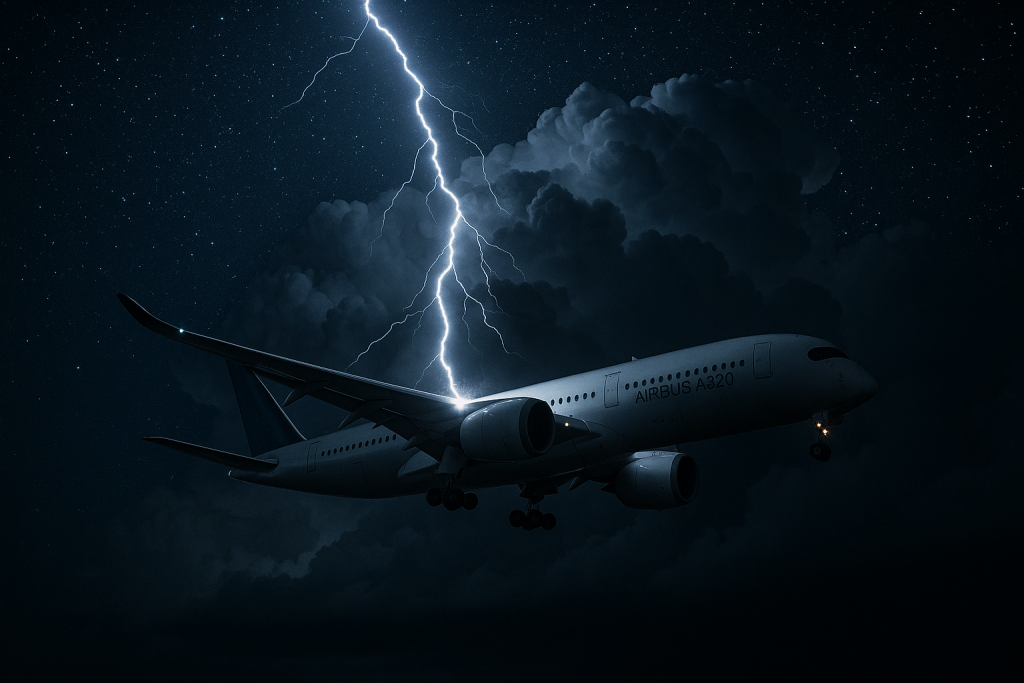✈️ ความเข้าใจผิดที่ 1: ฟ้าผ่าทำให้เครื่องบินตก
Misconception #1: Lightning can make a plane crash
หลายคนมักคิดว่า “ถ้าเครื่องบินโดนฟ้าผ่า คงตกแน่ ๆ” เพราะภาพในหนังหรือข่าวมักนำเสนอแบบนั้น แต่ในความเป็นจริง เครื่องบินพาณิชย์ทุกลำถูกออกแบบมาให้ทนต่อฟ้าผ่าได้ 100% ตามมาตรฐานความปลอดภัยขององค์กรการบินพลเรือน (เช่น FAA และ EASA)
Many people believe that if a plane is struck by lightning, it will crash. Movies and media often exaggerate this idea, but in reality, every commercial aircraft is engineered to fully withstand lightning strikes — as required by strict aviation safety standards set by authorities such as the FAA and EASA.
⚡ โครงสร้างเครื่องบินทำหน้าที่เหมือน “กรงฟาราเดย์”
Aircraft fuselage acts like a Faraday cage
ตัวเครื่องบินส่วนใหญ่ทำจากวัสดุนำไฟฟ้า เช่น อะลูมิเนียมหรือคาร์บอนคอมโพสิต ซึ่งช่วยให้กระแสไฟจากฟ้าผ่าสามารถไหลผ่านผิวเครื่องบินได้โดยไม่เข้าสู่ภายในห้องนักบินหรือห้องโดยสาร — คล้ายกับหลักการของ Faraday Cage ที่ใช้ป้องกันไฟฟ้าสถิตและคลื่นแม่เหล็กไฟฟ้า
The outer skin of an airplane is made of conductive materials like aluminum or carbon fiber composites. This allows the lightning current to travel safely along the surface and exit at another point without penetrating the cabin — the same principle as a Faraday Cage, which protects against electrical charges.
⚙️ ฟ้าผ่าเครื่องบินบ่อยแค่ไหน?
How often does lightning strike airplanes?
โดยเฉลี่ยแล้ว เครื่องบินพาณิชย์หนึ่งลำอาจถูกฟ้าผ่า ประมาณหนึ่งถึงสองครั้งต่อปี! ซึ่งฟังดูน่ากลัว แต่เกือบทั้งหมดเป็นเหตุการณ์ปกติที่ไม่มีผลกระทบต่อการบินเลย เพราะทุกระบบสำคัญ เช่น เครื่องยนต์ ระบบควบคุมการบิน และอุปกรณ์นำทาง ถูกป้องกันด้วยระบบ “bonding” และ “shielding”
On average, a commercial jet is struck by lightning once or twice a year — surprisingly common! But nearly all cases cause no harm because key systems, such as engines, flight controls, and navigation instruments, are fully protected through bonding and electrical shielding techniques.
🛠️ แล้วถ้าโดนจริง ๆ จะเกิดอะไรขึ้น?
What happens when lightning actually strikes?
เมื่อฟ้าผ่าลงเครื่องบิน กระแสไฟจะเข้าสู่จุดหนึ่งของลำตัว (เช่น ปลายจมูกหรือปลายปีก) แล้ววิ่งไปตามโครงสร้างโลหะ ก่อนออกทางจุดอื่น เช่น ปลายหางหรือส่วนปลายปีกอีกข้างหนึ่ง โดยอาจมี “รอยไหม้เล็ก ๆ” ที่ผิวโลหะ ซึ่งเป็นเรื่องปกติและตรวจเช็กได้ง่ายหลังลงจอด
When lightning strikes, the electrical current usually enters at one point (such as the nose or wingtip), travels along the metal skin, and exits at another — often at the tail or opposite wingtip. Sometimes it leaves a small burn mark on the surface, which is easily inspected and repaired after landing.

🧭 มาตรฐานการทดสอบและความปลอดภัย
Safety testing and certification standards
ก่อนออกแบบและผลิตจริง เครื่องบินทุกแบบต้องผ่านการทดสอบจำลองการฟ้าผ่าในห้องทดลอง โดยจำลองแรงดันไฟฟ้ากว่าล้านโวลต์ เพื่อพิสูจน์ว่าไม่มีผลกระทบต่อระบบอิเล็กทรอนิกส์และโครงสร้างหลัก นอกจากนี้ยังมีการตรวจสอบจุดต่อสายดิน (bonding points) ทุกครั้งในการบำรุงรักษา
Every aircraft design undergoes rigorous lightning-strike testing during certification — using simulated discharges of over one million volts to verify that no critical systems are affected. Maintenance inspections also include routine checks of bonding points and static discharge wicks.
✅ สรุป: ฟ้าผ่าไม่ใช่ปัญหา แต่ “ความเข้าใจผิด” ต่างหากคือสิ่งที่อันตราย
Lightning is not a threat — misunderstanding it is.
ฟ้าผ่าเครื่องบินไม่ได้อันตรายอย่างที่คิด และแทบไม่เคยเป็นสาเหตุของอุบัติเหตุทางอากาศในยุคสมัยใหม่เลย สิ่งสำคัญคือการเข้าใจว่า “เทคโนโลยีและมาตรฐานการบิน” ถูกออกแบบมาเพื่อรับมือกับธรรมชาติอย่างมีประสิทธิภาพที่สุด
Lightning strikes rarely, if ever, cause modern aircraft accidents. The key is understanding that aviation technology and safety design have evolved to handle even the forces of nature with remarkable precision and reliability.
